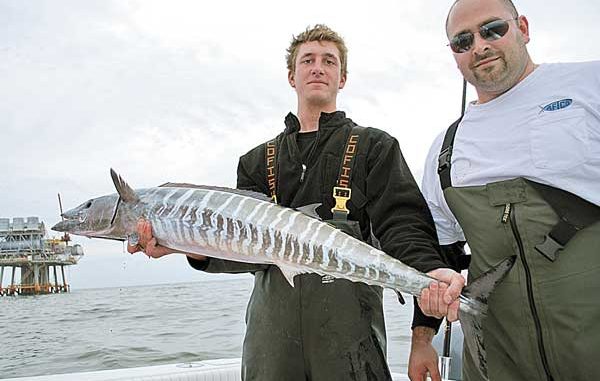
The Buras marsh is going bye bye, but what’s left of it still holds incredible early spring action.
What Louisiana saltwater fish is colored like a rainbow, lives in tunnels, can weigh more than 30 pounds and tastes like lobster?
Give up? The answer is the tilefish, sometimes called the golden tilefish.
Tilefish were first discovered in 1879 by a commercial cod fisherman off the Massachusetts coast, and given their scientific name of Lopholatilus chamaeleonticeps in 1980. Tilefish are now known to occur along the entire east Atlantic and Gulf of Mexico coasts on south as far as Venezuela in South America.
In the Gulf of Mexico off the Louisiana Coast, tilefish are found in waters 600 to 1,200 feet deep. In this zone, water temperatures are very stable and vary only a few degrees over the course of the year.
Tilefish are one of our most beautiful fish. Their backs and upper sides are aqua-blue with green highlights. This blends into a pinkish band that runs down their sides, which in turn blends into a silvery-yellow belly. The tail fin is golden with blue-green stripes, and the entire fish is covered with bright golden dots.
Its color is exceeded only by its taste. The flesh is snow-white with a fine flake that is very similar to that of freshwater crappie. Some people compare the taste of tilefish to that of lobster or crab. And indeed, much of the diet of tilefish consists of crabs and other crustaceans, with some finfish thrown in for variety.
Tilefish live a most unusual lifestyle. As noted earlier, they live in burrows in mud bottoms. Human divers in the northeastern United States, where tilefish live in somewhat shallower water, have worked out their habits. They spend the daylight hours moving slowly around bottom irregularities. They feed only during daylight hours, even though the penetration of sunlight to their depths is so low as to be nonexistent.
Feeding is most heavily done between 10 a.m. and 3 p.m., and takes place within 10 feet of the bottom. Their main food items are crabs and lobster-like crustaceans, although they don’t refuse clams, snails, starfish and finfish. Large tilefish apparently eat more finfish than small tilefish, and will even eat small tilefish when they get a chance.
It appears that tilefish will also scavenge, as garbage items from vessels, such as lamb chop bones and potato peelings, have been found in their stomachs.
They don’t eat everything, however. During an exploratory longline research project conducted by Louisiana State University scientists in the 1980s, some lines set in prime tilefish habitat were baited with freshwater crawfish. The assumption was that tilefish would eat any crustacean, and since crawfish were easy to procure, it was worth a try.
Not a single tilefish was caught on crawfish in repeated efforts, even though other lines baited with such unappetizing things as salted mullet that was hard as a plank caught the creatures. Go figure.
When night falls, tilefish do not just quit feeding, they retreat to their burrows in the bottom. Divers have observed a smaller fish, assumed to be a female, enter the burrow head-first. Then a larger fish, thought to be a male, settles down across the mouth of the burrow for the night.
Tilefish do not seem to school, as some other fish do. Rather, they live in groups or clusters. Fishermen fishing on tilefish grounds catch few other species with them. The most common fish caught with tilefish are a couple of species of groupers, although a few queen snappers may also be in the catch.
In the shallower end of their depth range, 600 to 750 feet deep, yellowedge grouper will be mixed in the tilefish catch. In mid-depths, 750 to 900 feet, the snowy grouper becomes more common. Neither of these two grouper species is noted for being strongly associated with reefs, ledges and shipwrecks.
In waters deeper than 900 feet, the catch is almost entirely tilefish, although some deepwater oddities will be caught.
In spite of the abundance of tilefish in the northern Gulf of Mexico, a stable fishery for the species has never been established for this excellent food fish. Louisiana’s
commercial landings of tilefish peaked in 1988 at 282,486 pounds. In 2007, the last year for which commercial landings are complete, the take was a paltry 5,016 pounds.
Some of this is due to the heavy regulation of longlines to reduce the harvest of red snapper. A lot of tilefish where incidentally caught and landed by fishermen using longlines to target groupers and snappers. With heavy regulation, many longliners left the Gulf, shifted to the use of other equipment or went out of business.
A focused recreational fishery does not exist either. The depths at which the fish live means they are found far from shore except near the mouth of the Mississippi River, and there the bottoms seem to be too soft to support the habits of this fish.
Most offshore sport fishermen in Louisiana have been spoiled by the ease of fishing at oil platforms, and do little to explore the Gulf’s open bottoms. A few venturesome souls, however, are beginning to plumb the depths with electric reels.
Tilefish are regulated under an aggregate bag limit with lane snapper, vermilion snapper and almaco jacks. In combination, no more than 20 of these fish are allowed per person.
Jerald Horst is an author of the Angler’s Guide to Fishes of the Gulf of Mexico, a 444-page, color-illustrated book on fishes written for saltwater fishermen. The book is available in better bookstores, or can be ordered by calling 800-843-1724.


